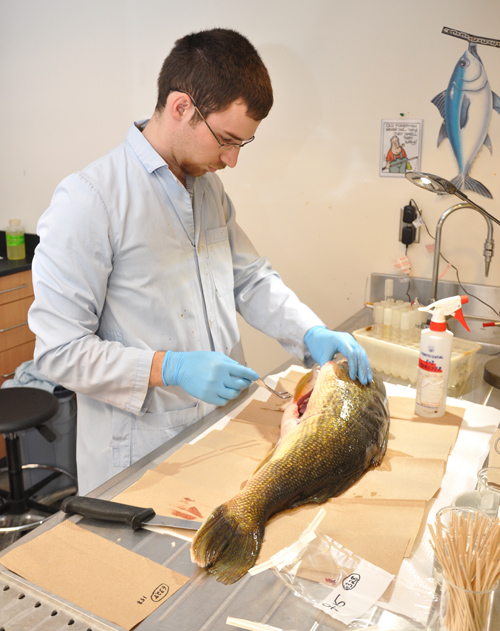
Carving knife in hand, fourth-year microbiology student Jon Vyskocil slices into the belly of a walleye – but it’s not for lunch. The fish lying on the “operating table” is one of about 120 specimens that have arrived today to be dissected in Prof. Roselynn Stevenson’s lab, which studies the microbial pathogens of wild and farmed freshwater fish.
The fish come from the hatchery program operated by the Ontario Ministry of Natural Resources (OMNR). The spawn of wild fish, hatchery fish are raised for conservation and remediation programs. Under its fish disease control program, the Great Lakes Fishery Commission prohibits the release of diseased fish into water bodies of the basin, so the fish need to pass a health exam first.
“We’re looking for specific disease agents amongst all of their hatcheries plus any wild fish they collect,” says lab technician Steve Lord. Although OMNR sends mostly healthy fish to the lab, he adds, “If they do have a disease situation in the hatchery, they will send fish to us, and we’ll try to diagnose it, which is usually the more fun part of the job.”
The lab looks for a list of pathogens in fish specimens. The federal Department of Fisheries and Oceans, the Canadian Food Inspection Agency and international trade agreements require that fish be tested for certain types of diseases before being moved across borders. “You can’t ship fish that are carriers of particular diseases,” says Stevenson, Department of Molecular and Cellular Biology. “Most of the concerns are viral diseases.”
Viral hemorrhagic septicemia virus, which had never been seen before in Canadian or American inland waters, caused major fish losses in 2006. That’s why the lab is always on the lookout for new and emerging disease threats. “Pathogens are becoming more global,” says Lord. Although ballast water from ships has been suggested as a source, some disease agents may have always been in the local environment.
Some pathogens are believed to live inside amoebas after being consumed. When the amoebas are stressed, they enter a resting phase, encasing themselves in a protective cyst. The cyst also protects any pathogens hiding inside the amoebas, making them resistant to disinfection methods such as chlorination.
The lab uses bacteriology, parasitology and virology to identify pathogens. Improving detection methods such as molecular techniques is important to pinpoint those pathogens faster.
Aside from disease detection, the lab also studies how these diseases spread and how they survive in the environment. “Where are they when they’re not causing disease or not in fish carriers?” says Stevenson. “Why doesn’t the fish get rid of them through its normal immune process? Are they particularly structured so that they can sneak around the immune system of the fish?”
Some diseases can be transmitted from the parent fish to their eggs and milt (sperm). Both parents are tested for diseases before their offspring hatch so that potentially infected eggs can be eliminated. Fish can also pick up pathogens when they eat fecal matter from infected fish. Although fish need water to survive, it can also be their worst enemy. “Almost all pathogens can survive in water, which fish live in, breathe and drink,” says Lord. “They’re living in a good transfer medium.”
Fish can be pathogen carriers without showing any symptoms until they become stressed by such factors as overcrowding, being handled or moved, or warmer water.
Vaccination is one approach to protecting against infection. But various species of fish have different types of immune systems, which means that vaccines need to be tailored to their particular immune response. “They have antibody-producing cells,” says Stevenson, “and they have cellular immunity, which is important for protection against viruses.”
Specimens arrive weekly in coolers from OMNR’s fisheries across Ontario. Lab members dissect each fish and take tissue samples from filtering organs such as the gills, spleen, liver and kidneys. To isolate any viruses, the researchers homogenize and centrifuge the samples and pass them through a membrane filter. The viruses are then cultured in live fish cells. If the cells die, the lab needs to identify whether the cause was a toxin or pathogen.
Lord, B.Sc. ’83, describes himself as a “lifer” in Stevenson’s lab: he has been working there for more than 25 years, and he’s also a former student of hers. After graduation, he was offered a temporary position that never ended. He took to his new job like a fish to water, but it wasn’t fish that drew him to the lab; it was microbiology.
Master’s student Iwona Skulska, B.Sc. ’10, also works in the lab. “I’ve always been interested in marine microbiology,” she says. She did her undergraduate research project with Stevenson on Yersinia ruckeri, a bacterium that causes enteric redmouth disease in salmonids. She’s now studying gill disease, in which bacteria coat gills and cause the fish to suffocate.
“Bacterial gill disease is certainly one of the biggest threats in the hatcheries, and it drives a lot of the research that’s done here,” says Lord.
Dissecting fish on a regular basis in the lab comes in handy at the dining table, Stevenson jokes: “We know where the bones are.”